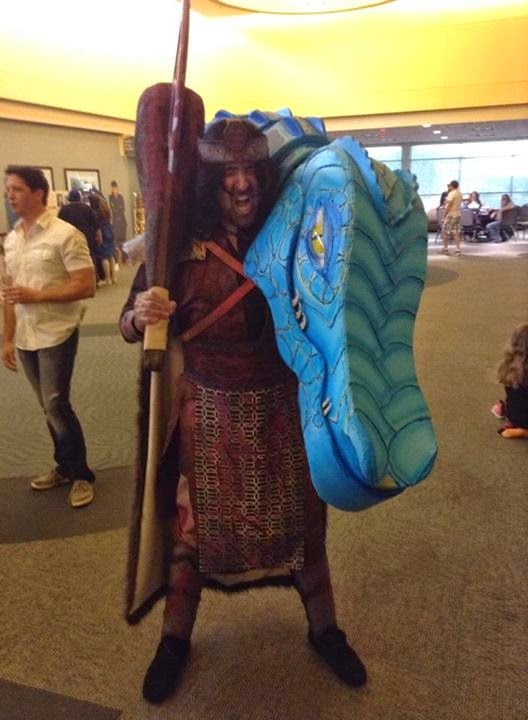 |
| Photo by Bryan Crump modelmayhem.com |
I've been making costumes and props for about a decade now. I'm not the best at it, but I enjoy the process of the build and showing them off at comic book conventions. With San Diego Comic Con being held this weekend (which I'm NOT at, darn it), I'm jealous of all the great costumers that are showing their wares. They are all over the news today! So in honor of the weekend, I wanted to share my last costume build with you...because I think the build is just as interesting as the costume itself.
I'll think about a costume for several months before beginning to cut/paint/sew anything, and this costume was no different. Oddly though, I'd been uninspired for several months but in Jan. 2014 I dreamed about being a local convention, All-Con, where I was going to show a Dragon Slayer costume with a six-foot tall decapitated dragon head in tow. I woke that next morning, drove to a local foam store, Allied Foam, and bought a ten-foot roll of closed cell foam to make the dragon head, then to Jo Ann Fabrics for all my costume's fabric needs. I had been inspired in a dream and was finally motivated! After a couple false starts (I'll detail that in the photo captions), I finished the costume in time to compete in the costume contest at Sooner Con 2014.
Like I said, I enjoy showing the costumes, and prepping for a contest helps me to make sure that my pieces are as good as they can be--given my limited abilities. That said, I'd won Best of Show at Sooner Con three times previously (2007, 2010, 2012) so I had to put up a costume that at least didn't betray those previous wins.
How did I do at the contest? Details below. I don't want to ruin it for you!
The following pics are a short record of the building process. I'll try to keep the descriptions as short as possible, so my apologies if the text gets lengthy.
 |
| I made this paper "test dragon" to see if my ideas would pan out in a three-dimensional, real-life mode. |
 |
| Relying heavily on my paper dragon, I began to cut out pieces of foam on a scaled-up size. First the neck and under- jaw, then the upper jaw. I used hot-melt glue to attach all the foam pieces |
 |
| Then I added the upper/side of the face, then the forehead. The nice depression near the nostrils was a happy accident! |
 |
| Here you can see the head without the neck. By the next photo, I'd added some segmented neck pieces. |
 |
| For the base of the eye, I used large serving spoons. I cut off the handles, painted the backs with glossy car-model paint... |
 |
| ...and glued them on! I think they work, even if they look too "alive." By that, I mean that the dragon looks awake and not recently decapitated. |
 |
| My base layer of paint was just a few tubes of acrylic paint from Hobby Lobby that I layed down with a regular brush. |
 |
| Flipping the dragon over, I used regular spary paint to coat the neck. |
 |
| Some more airbrushing, some fake teeth (plastic grizzly bear teeth and claws bought from a Boy Scout supply site) and I'm almost done. |
 |
| At the same time I started the dragon head, I cut out this profile for my Dragon Slayer ax. I envisioned a very large blade embedded into a heavy, caveman-like club. |
 |
| I sealed the foam with Plasti Dip, then painted and detailed with the airbrush. It ended up a little cartoony, but no one was really looking at the club. |
 |
| I used styrene to make the battle helmet. No heat forming, just cut, bend and rivet. |
 |
| For the contest, I made a HUGE sack to drag the dragon, keeping him hidden until the last minute, when I tore it open and heaved it over my head. Just like my dream, the crowd went nuts! |
Well, after all that, I ended up winning Best of Show, again. That's four time! The prize was a $1200 Bernina sewing machine--not too shabby. Big thanks to Bernina of OKC for donating the prize and sponsoring the contest.
Not quite sure what my next project will be, but I had a blast with this one. If you have any questions about how I did anything here, drop me a line. I'm more than happy to share all of my "secrets".


















No comments:
Post a Comment